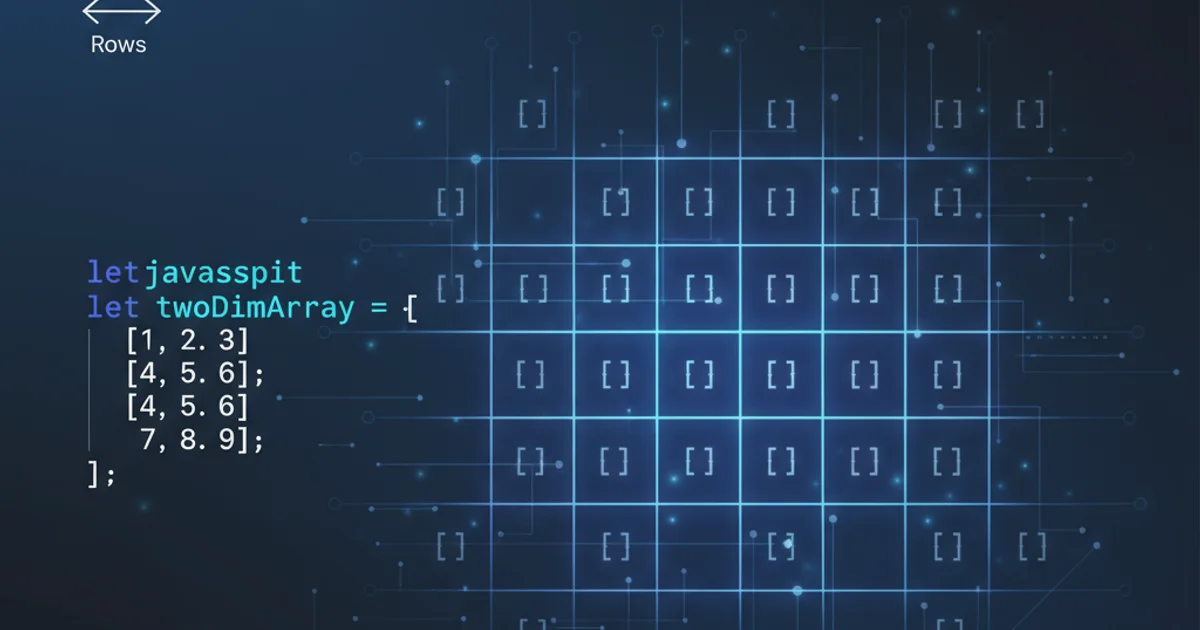How can I create a two dimensional array in JavaScript?
Categories:
Mastering Two-Dimensional Arrays in JavaScript

Explore various techniques for creating and manipulating 2D arrays (matrices) in JavaScript, from basic nested arrays to more advanced methods.
While JavaScript doesn't have native support for true multi-dimensional arrays like some other languages, you can effectively simulate them using arrays of arrays. This article will guide you through different approaches to create, initialize, and work with two-dimensional data structures, often referred to as matrices, in JavaScript. Understanding these techniques is crucial for tasks like game development, data visualization, and complex data processing.
Understanding the Concept of 2D Arrays
A two-dimensional array can be thought of as a grid or a table, where data is organized in rows and columns. Each element in the grid is accessed using two indices: one for the row and one for the column. In JavaScript, this is achieved by creating an array where each element is itself another array. The outer array represents the rows, and the inner arrays represent the columns for each respective row.
graph TD
A[2D Array] --> B[Outer Array (Rows)]
B --> C1[Inner Array (Row 0)]
B --> C2[Inner Array (Row 1)]
B --> C3[Inner Array (Row N)]
C1 --> D1[Element (0,0)]
C1 --> D2[Element (0,1)]
C2 --> E1[Element (1,0)]
C2 --> E2[Element (1,1)]
style A fill:#f9f,stroke:#333,stroke-width:2px
style B fill:#bbf,stroke:#333,stroke-width:2px
style C1 fill:#ccf,stroke:#333,stroke-width:1px
style C2 fill:#ccf,stroke:#333,stroke-width:1px
style C3 fill:#ccf,stroke:#333,stroke-width:1px
style D1 fill:#ddf,stroke:#333,stroke-width:1px
style D2 fill:#ddf,stroke:#333,stroke-width:1px
style E1 fill:#ddf,stroke:#333,stroke-width:1px
style E2 fill:#ddf,stroke:#333,stroke-width:1pxConceptual structure of a 2D array in JavaScript.
Method 1: Manual Initialization
The simplest way to create a 2D array is by manually declaring an array of arrays. This is suitable for small, fixed-size matrices where you know the values beforehand. Each inner array represents a row, and its elements are the column values.
// Creating a 3x3 2D array manually
const matrix = [
[1, 2, 3],
[4, 5, 6],
[7, 8, 9]
];
console.log(matrix[0][0]); // Output: 1
console.log(matrix[1][2]); // Output: 6
console.log(matrix[2][1]); // Output: 8
Manual initialization of a 3x3 2D array.
Method 2: Programmatic Initialization with Loops
For creating 2D arrays of a specific size and initializing them with default values (like null, 0, or an empty string), nested for loops are a common and effective approach. This allows you to define the number of rows and columns dynamically.
function create2DArray(rows, cols, defaultValue = 0) {
const arr = [];
for (let i = 0; i < rows; i++) {
arr.push([]); // Create an empty inner array for each row
for (let j = 0; j < cols; j++) {
arr[i].push(defaultValue); // Populate the inner array with default values
}
}
return arr;
}
const grid = create2DArray(4, 3, 'X');
console.log(grid);
Creating a 4x3 2D array initialized with 'X' using nested loops.
defaultValue parameter makes this function versatile. You can initialize your matrix with any value, including other arrays or objects, though be mindful of reference types.Method 3: Using Array.from() and map()
Modern JavaScript provides more concise ways to create and initialize arrays. The Array.from() method, combined with map(), offers an elegant functional approach to generate 2D arrays. This method is often preferred for its readability and immutability when creating new arrays.
function create2DArrayFunctional(rows, cols, defaultValue = null) {
return Array.from({ length: rows }, () =>
Array.from({ length: cols }, () => defaultValue)
);
}
const board = create2DArrayFunctional(3, 3, 0);
console.log(board);
/* Output:
[
[0, 0, 0],
[0, 0, 0],
[0, 0, 0]
]
*/
Creating a 3x3 2D array initialized with 0 using Array.from().
Array(rows).fill(Array(cols).fill(defaultValue)) will result in all rows referencing the same inner array, leading to unexpected behavior when modifying elements. Always ensure each inner array is a distinct instance.Accessing and Modifying Elements
Once a 2D array is created, accessing and modifying its elements is straightforward using bracket notation [row][column]. Iterating through a 2D array typically involves nested loops, where the outer loop handles rows and the inner loop handles columns.
const gameBoard = [
['X', 'O', 'X'],
['O', 'X', 'O'],
['X', 'O', 'X']
];
// Accessing an element
console.log(gameBoard[0][1]); // Output: 'O'
// Modifying an element
gameBoard[1][1] = ' '; // Clear the center square
console.log(gameBoard[1][1]); // Output: ' '
// Iterating through the array
for (let i = 0; i < gameBoard.length; i++) { // Iterate rows
for (let j = 0; j < gameBoard[i].length; j++) { // Iterate columns
console.log(`Element at (${i}, ${j}): ${gameBoard[i][j]}`);
}
}
Accessing, modifying, and iterating elements in a 2D array.